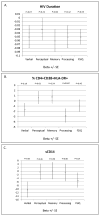Neurocognitive dysfunction in HIV-infected youth: investigating the relationship with immune activation
- PMID: 28327462
- PMCID: PMC5940002
- DOI: 10.3851/IMP3157
Neurocognitive dysfunction in HIV-infected youth: investigating the relationship with immune activation
Abstract
Background: HIV-infected individuals are at increased risk of neurocognitive impairment compared to the general population. Studies suggest that, despite combination antiretroviral therapy (cART), HIV infection causes immune activation which results in neural damage; however, few data exist in HIV-infected youth.
Methods: HIV-infected youth 8-26-years-old on cART with virological suppression were prospectively enrolled along with healthy controls. Neurocognitive performance was assessed by age-appropriate Wechsler Intelligence Scales. Soluble and cellular markers of T-lymphocyte and monocyte activation were measured by ELISA and flow cytometry, respectively.
Results: 45 HIV-infected subjects and 21 controls were enrolled. Markers of T-cell and monocyte activation were higher in the HIV-infected subjects compared to controls, but proportions of inflammatory and patrolling monocytes were similar. Although there were no significant differences in neurocognitive scores between the HIV-infected and control groups, scores were low-average for four of five testing domains for the HIV-infected subjects and average for all five in the controls, and % of HIV-infected subjects with scores classified as 'low average' or below was higher than in the controls. Variables most associated with neurocognitive performance among HIV-infected subjects included activated CD4+ T-cells (% CD4+CD38+HLA-DR), monocyte activation (soluble CD14), HIV duration, age and sex.
Conclusions: HIV-infected youth on cART with virological suppression show subtle evidence of neurocognitive impairment compared to healthy controls, and increased immune activation appears to play a role. Additional studies are needed to develop strategic interventions beyond cART to potentially improve neurocognitive performance and/or minimize further impairment in this vulnerable population. ClinicalTrials.gov Identifier: NCT01523496.
Conflict of interest statement
Figures



Similar articles
-
Vitamin D supplementation decreases immune activation and exhaustion in HIV-1-infected youth.Antivir Ther. 2018;23(4):315-324. doi: 10.3851/IMP3199. Antivir Ther. 2018. PMID: 28994661 Free PMC article. Clinical Trial.
-
Increased Immune Activation and Exhaustion in HIV-infected Youth.Pediatr Infect Dis J. 2016 Dec;35(12):e370-e377. doi: 10.1097/INF.0000000000001326. Pediatr Infect Dis J. 2016. PMID: 27626922 Free PMC article.
-
Higher soluble CD14 levels are associated with lower visuospatial memory performance in youth with HIV.AIDS. 2019 Dec 1;33(15):2363-2374. doi: 10.1097/QAD.0000000000002371. AIDS. 2019. PMID: 31764101 Free PMC article.
-
Peripheral immune dysregulation in the ART era of HIV-associated neurocognitive impairments: A systematic review.Psychoneuroendocrinology. 2020 Aug;118:104689. doi: 10.1016/j.psyneuen.2020.104689. Epub 2020 May 29. Psychoneuroendocrinology. 2020. PMID: 32479968
-
HIV-associated neurocognitive disorder and HIV-associated myelopathy in a patient with a preserved CD4, but high viral load-a rarely reported phenomenon: a case report and literature review.BMC Infect Dis. 2020 Aug 5;20(1):574. doi: 10.1186/s12879-020-05297-9. BMC Infect Dis. 2020. PMID: 32758161 Free PMC article. Review.
Cited by
-
Plasma Citrate and Succinate Are Associated With Neurocognitive Impairment in Older People With HIV.Clin Infect Dis. 2021 Aug 2;73(3):e765-e772. doi: 10.1093/cid/ciab107. Clin Infect Dis. 2021. PMID: 33564870 Free PMC article.
-
HIV-related cognitive disorders in children in Kinshasa (Democratic Republic of Congo).BMC Public Health. 2024 Jul 29;24(1):2033. doi: 10.1186/s12889-024-19398-6. BMC Public Health. 2024. PMID: 39075395 Free PMC article.
-
Vitamin D supplementation decreases immune activation and exhaustion in HIV-1-infected youth.Antivir Ther. 2018;23(4):315-324. doi: 10.3851/IMP3199. Antivir Ther. 2018. PMID: 28994661 Free PMC article. Clinical Trial.
-
Psychometric evaluation of the computerized battery for neuropsychological evaluation of children (BENCI) among school aged children in the context of HIV in an urban Kenyan setting.BMC Psychiatry. 2023 May 29;23(1):373. doi: 10.1186/s12888-023-04880-z. BMC Psychiatry. 2023. PMID: 37248481 Free PMC article.
-
Early ART-initiation and longer ART duration reduces HIV-1 proviral DNA levels in children from the CHER trial.AIDS Res Ther. 2021 Sep 29;18(1):63. doi: 10.1186/s12981-021-00389-1. AIDS Res Ther. 2021. PMID: 34587974 Free PMC article.
References
-
- Van Rie AHP, Dow A, Robertson K. Neurologic and neurodevelopmental manifestations of pediatric HIV/AIDS: A global perspective. European journal of paediatric neurology : EJPN : official journal of the European Paediatric Neurology Society. 2007;11:1–9. - PubMed
-
- Schouten J, Cinque P, Gisslen M, Reiss P, Portegies P. HIV-1 infection and cognitive impairment in the cART era: a review. Aids. 2011 Mar 13;25(5):561–575. - PubMed
-
- Drotar D, Olness K, Wiznitzer M, et al. Neurodevelopmental outcomes of Ugandan infants with HIV infection: an application of growth curve analysis. Health Psychol. 1999 Mar;18(2):114–121. - PubMed
-
- Gay CL, Armstrong FD, Cohen D, et al. The effects of HIV on cognitive and motor development in children born to HIV-seropositive women with no reported drug use: birth to 24 months. Pediatrics. 1995 Dec;96(6):1078–1082. - PubMed
Publication types
MeSH terms
Substances
Associated data
Grants and funding
LinkOut - more resources
Full Text Sources
Other Literature Sources
Medical
Research Materials

